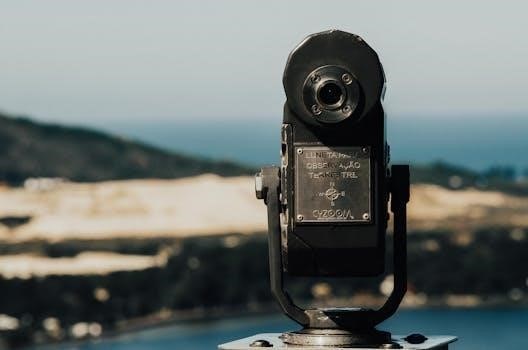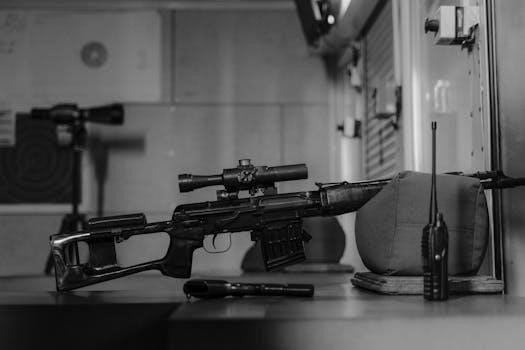William Optics Guide Scopes⁚ An Overview
William Optics guide scopes are known for their top-notch quality, fitting seamlessly with William Optics telescopes. Designed for precision tracking, these guide scopes enhance astrophotography, ensuring clear, detailed long-exposure images for both beginners and experienced users alike.
William Optics guide scopes are designed to improve tracking accuracy for astrophotography. These compact telescopes, such as the 50mm and 32mm models, attach to larger imaging telescopes, allowing precise guiding during long-exposure shots. Featuring high-quality optics, they ensure stars remain sharp and pinpoint, even with extended exposure times. With user-friendly designs, William Optics guide scopes provide essential tools for both beginners and experienced astrophotographers, offering sturdy construction and reliable performance. Their guide scopes come equipped with either a Roto Lock or slide-base for ease of use.
Key Features of William Optics Guide Scopes
William Optics guide scopes stand out with their precision optics and robust build. Key features include versatile focusing mechanisms and considerations for aperture and focal ratio, optimizing performance for astrophotography and ensuring sharp, clear guiding.
Aperture and Focal Ratio Considerations
When selecting a William Optics guide scope, aperture and focal ratio are vital. The 50mm guide scope offers substantial light-gathering, suitable for telescopes with longer focal lengths. For wide-field rigs (600mm or less), a 32mm guide scope might suffice. A faster focal ratio, like f/4, provides a wider field of view, simplifying guide star acquisition. The aperture affects light-gathering ability, while the focal ratio determines the field of view, balancing sensitivity and coverage for effective guiding performance during astrophotography sessions.
Focusing Mechanisms⁚ Roto Lock and Slide-Base
William Optics guide scopes employ focusing mechanisms like Roto Lock and slide-base designs. The Roto Lock ensures secure camera attachment, maintaining precise focus during imaging. Slide-base designs offer a rigid, stable platform, simplifying adjustments. The Roto Lock mechanism allows easy and secure rotation to help with camera orientation. The slide-base reduces flexure. Focusing with mechanisms like twisting the dew shield until an image is sharp, and then tightening a locking ring for stable guiding.
Popular William Optics Guide Scope Models
Popular William Optics guide scope models include the 50mm Guide Scope with 1.25″ Roto Lock and the 32mm Slide-base Uniguide Scope. Both are well-regarded for their quality and performance in astrophotography setups.
William Optics 50mm Guide Scope with 1.25″ Roto Lock
The William Optics 50mm Guide Scope with 1.25″ Roto Lock features a 50mm aperture and f/4 focal ratio, granting ample light-gathering ability. It is effective for guiding, often achieving RMS values between 0.3 and 0.6 when paired with mounts like the Sky-Watcher EQ6R-Pro. The Roto Lock provides a secure connection for guide cameras. It may be overkill for imaging telescopes with focal lengths up to 600mm; the 32mm Slide-base Uniguide Scope might be preferable in those cases;
William Optics 32mm Slide-base Uniguide Scope
The William Optics 32mm Slide-base Uniguide Scope features a 32mm lens with a 120mm focal length (f/3.75) and weighs just 8.5oz (240g). This guide scope is well-suited for wide-field astrophotography setups. It provides a rigid slide-base design, a preferable alternative to finicky guide rings. Focusing is achieved by twisting the dew shield until the image becomes sharp, then locking it with a locking ring. When paired with cameras like the ZWO ASI 120MM Mini, it offers a perfect match for guiding purposes.
Advantages of Using a William Optics Guide Scope
William Optics guide scopes provide improved tracking accuracy for astrophotography, ensuring detailed long-exposure images. Their light-gathering ability and wide field of view simplify locating guide stars, enhancing overall guiding performance during observations.
Improved Tracking Accuracy for Astrophotography
William Optics guide scopes significantly enhance tracking accuracy, crucial for astrophotography. By maintaining precise alignment, they enable longer exposure times without star trailing, capturing finer details in celestial objects. The robust design and quality optics contribute to a stable guiding platform, minimizing errors caused by vibrations or mechanical flex. With guiding RMS routinely in the 0.3 to 0.6 range, they ensure sharper, more detailed images, even with longer focal length imaging telescopes. Achieving optimal guiding performance allows astrophotographers to produce professional-quality results.
Light Gathering Ability and Field of View
William Optics guide scopes, such as the 50mm f/4 model, offer excellent light-gathering capabilities due to their large aperture and fast focal ratio. This allows for the easy detection of guide stars, even in faint areas of the sky. The wide field of view, approximately 5.7º in the 50mm model, simplifies the process of locating suitable guide stars, making them ideal for use with various imaging telescopes. A broader view means more potential guide stars, enhancing the ability to maintain accurate tracking during astrophotography sessions.

Mounting and Compatibility
William Optics guide scopes are designed for seamless integration. They are compatible with William Optics telescopes and various other brands. Offering flexible mounting, these guide scopes can use guide rings or a slide-base for secure attachment.
Compatibility with William Optics and Other Telescopes
William Optics guide scopes are engineered to seamlessly integrate not only with William Optics telescopes but also with a wide array of other telescope brands. This versatility ensures that astrophotographers can utilize these guide scopes regardless of their primary imaging equipment. The design considerations include standard mounting interfaces that allow for easy attachment to various telescope setups. Whether using a William Optics refractor or another brand’s optical tube, these guide scopes offer a compatible and reliable guiding solution, enhancing the overall astrophotography experience and guaranteeing optimal performance.
Mounting Options⁚ Guide Rings vs. Slide-Base
William Optics guide scopes offer flexible mounting solutions to accommodate different astrophotography setups. Guide rings provide a traditional method, allowing precise alignment of the guide scope parallel to the main telescope, though they can sometimes be finicky. Alternatively, the slide-base design, seen in models like the UniGuide, offers a more rigid and stable connection. This design simplifies setup and maintains alignment more effectively. The choice between guide rings and a slide-base depends on user preference and specific equipment needs, both ensuring secure attachment and optimal guiding performance for astrophotography.

Guide Cameras and Accessories
Enhance your William Optics guide scope with recommended guide cameras like the ZWO ASI120MM Mini or ASI290MM Mini. Essential accessories include Bahtinov masks to achieve precise focus, maximizing guiding accuracy for astrophotography sessions.
Recommended Guide Cameras (e.g., ZWO ASI120MM Mini, ASI290MM Mini)
Selecting the right guide camera is crucial for optimal guiding performance with William Optics guide scopes. Popular choices include the ZWO ASI120MM Mini and ASI290MM Mini, known for their sensitivity and compact size. These cameras offer excellent performance in capturing guide stars, enabling accurate tracking during long-exposure astrophotography. The ASI120MM Mini is a cost-effective option, while the ASI290MM Mini provides higher resolution. Ensure the camera is compatible with your guiding software for seamless integration and enhanced guiding precision. Consider factors like pixel size and sensor size for the best results.
Essential Accessories⁚ Bahtinov Masks
Bahtinov masks are indispensable accessories for achieving precise focus with William Optics guide scopes. These masks create a distinct diffraction pattern that allows for accurate focusing on stars. By carefully adjusting the focus until the diffraction spikes are perfectly centered, you can ensure optimal sharpness for guiding. This precise focusing is critical for accurate tracking during astrophotography. Bahtinov masks are available in various sizes to fit different guide scope apertures. Using a Bahtinov mask significantly simplifies and improves the focusing process, leading to better guiding performance and sharper astrophotography images.

Using the William Optics Guide Scope
Effective use involves careful focusing techniques, often aided by a Bahtinov mask. Achieving optimal guiding performance requires precise adjustments and a stable mount, ensuring accurate tracking for clear astrophotography results.
Focusing Techniques
Focusing a William Optics guide scope is crucial for achieving optimal guiding performance. One common method involves twisting the dew shield until a sharp image is obtained, followed by tightening the locking ring to secure the focus. For more precise focusing, a Bahtinov mask can be used to create diffraction spikes, allowing for fine-tuning until the spikes are perfectly centered. This ensures that guide stars are sharply focused on the guide camera sensor, leading to improved tracking accuracy during astrophotography sessions. Proper focus is essential for effective guiding with the William Optics guide scope.
Achieving Optimal Guiding Performance
To achieve optimal guiding performance with a William Optics guide scope, several factors must be considered. Start with precise focusing using techniques like a Bahtinov mask. Ensure the guide camera is securely mounted and properly connected to the guiding software. Calibrate the guiding system in the software, such as PHD2, and adjust the guiding parameters to match the specific mount and seeing conditions. A stable and rigid mounting setup for the guide scope is essential to minimize flexure. Regularly monitor and adjust guiding parameters as needed for best results. Good seeing conditions also play a significant role.

Alternatives to William Optics Guide Scopes
While William Optics offers quality guide scopes, alternatives like Svbony guide scopes exist. These options provide different price points and feature sets, catering to various astrophotography needs and preferences, ensuring there’s a suitable choice for every astronomer.
Svbony Guide Scopes
Svbony guide scopes present a budget-friendly alternative in the astrophotography market. They offer various models designed to assist with precise tracking during long-exposure imaging. While often more affordable than William Optics, Svbony guide scopes still aim to provide reliable performance for guiding. Reviews and user experiences can help determine if a Svbony guide scope meets the specific requirements of your astrophotography setup, balancing cost with desired accuracy and build quality for effective tracking.
William Optics guide scopes offer precision and quality for astrophotography, enhancing tracking accuracy. While pricier, their robust design and performance make them a worthwhile investment. Consider needs and budget when choosing alternatives.
William Optics guide scopes provide superior tracking for astrophotography, ensuring sharper images with minimal errors. Models like the 50mm ROTO Lock and 32mm Slide-base Uniguide offer versatility for different setups. Key benefits include robust build quality, precise focusing mechanisms, and compatibility with various telescopes and cameras, such as ZWO ASI models.
However, consider the focal length of your imaging telescope; a shorter focal length may suit a smaller guide scope. Weigh the cost against alternatives like Svbony, balancing quality with budget. Ultimately, William Optics guide scopes are reliable tools for dedicated astrophotographers seeking optimal results.
